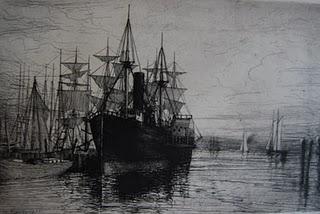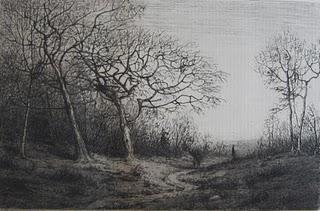 Henry Farrer, On New York BayEtching, 1879
Henry Farrer, On New York BayEtching, 1879 Henry Farrer, MarineEtching, 1880
Henry Farrer, MarineEtching, 1880Henry Farrer was born in London in 1843. He emigrated to the USA in 1863 at the age of twenty. Farrer was very much a driving force in the American etching revival. Most of his etchings are seascapes or landscapes, though the first, made in 1868, were views of New York buildings.
 Henry Farrer, The LighthouseEtching, 1881
Henry Farrer, The LighthouseEtching, 1881 Henry Farrer, Sunset, Gowanus BayEtching, 1880
Henry Farrer, Sunset, Gowanus BayEtching, 1880Most of Henry Farrer's seascapes are views of New York Harbor, a subject he rendered with great vigour and great sensitivity.
 Henry Farrer, Sunset, New York HarborEtching, 1879
Henry Farrer, Sunset, New York HarborEtching, 1879 Henry Farrer, TwilightEtching, 1880
Henry Farrer, TwilightEtching, 1880Farrer loved the mysterious time of twilight, when the world hovers between daylight and darkness, and returned to sunset scenes time and again.
 Henry Farrer, Woods in WinterEtching, 1880
Henry Farrer, Woods in WinterEtching, 1880 Henry Farrer, DecemberEtching, 1879
Henry Farrer, DecemberEtching, 1879Wintry scenes were another staple of Henry Farrer's art. Something in him responded to the dying months of the year just as it did to the last rays of the setting sun.
 Henry Farrer, The Last Walk in AutumnEtching, 1881
Henry Farrer, The Last Walk in AutumnEtching, 1881Henry Farrer's older brother, Thomas Charles Farrer, was also an artist, who studied under John Ruskin and Dante Gabriel Rossetti. In America, Thomas founded the idealistic, Pre-Raphaelite, Society for the Advancement of Art and Truth, of which Henry became a member. However, Henry Farrer soon went beyond his brother's Pre-Raphaelite influence, adopting a tonalist approach in his watercolours and etchings. As well as the New York Etching Club, Henry Farrer also co-founded the American Watercolor Society. Henry Farrer died in 1903.

